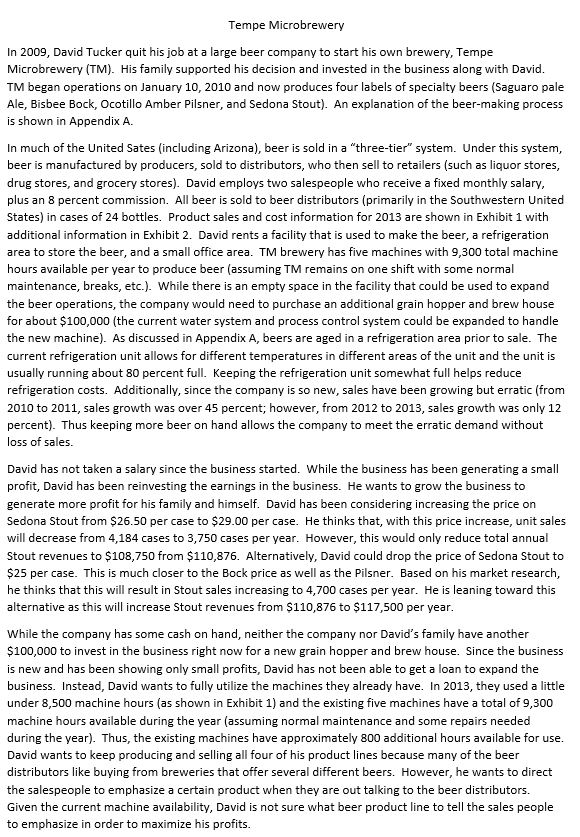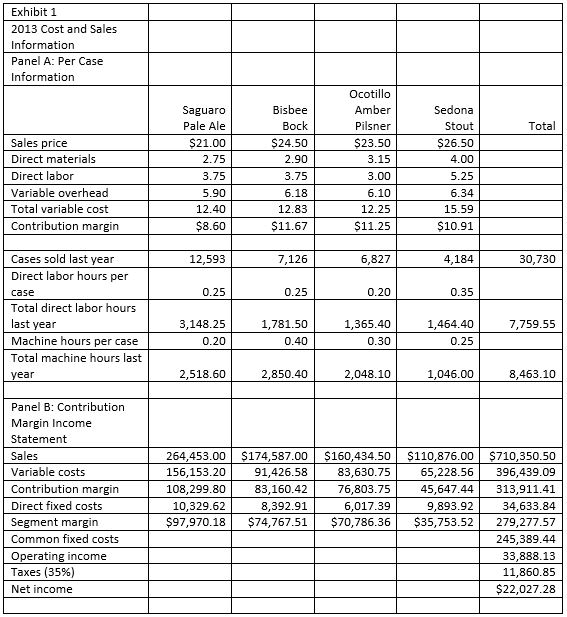



Tempe Microbrewery In 2009, David Tucker quit his job at a large beer company to start his own brewery, Tempe Microbrewery (TM). His family supported his decision and invested in the business along with David. TM began operations on January 10, 2010 and now produces four labels of specialty beers (Saguaro pale Ale, Bisbee Bock, Ocotillo Amber Pilsner, and Sedona Stout). An explanation of the beer-making process is shown in Appendix A. In much of the United Sates (including Arizona), beer is sold in a "three-tier" system. Under this system, beer is manufactured by producers, sold to distributors, who then sell to retailers (such as liquor stores, drug stores, and grocery stores). David employs two salespeople who receive a fixed monthly salary, plus an 8 percent commission. All beer is sold to beer distributors (primarily in the Southwestern United States) in cases of 24 bottles. Product sales and cost information for 2013 are shown in Exhibit 1 with additional information in Exhibit 2. David rents a facility that is used to make the beer, a refrigeration area to store the beer, and a small office area. TM brewery has five machines with 9,300 total machine hours available per year to produce beer (assuming TM remains on one shift with some normal maintenance, breaks, etc.). While there is an empty space in the facility that could be used to expand the beer operations, the company would need to purchase an additional grain hopper and brew house for about $100,000 (the current water system and process control system could be expanded to handle the new machine). As discussed in Appendix A, beers are aged in a refrigeration area prior to sale. The current refrigeration unit allows for different temperatures in different areas of the unit and the unit is usually running about 80 percent full. Keeping the refrigeration unit somewhat full helps reduce refrigeration costs. Additionally, since the company is so new, sales have been growing but erratic (from 2010 to 2011, sales growth was over 45 percent; however, from 2012 to 2013, sales growth was only 12 percent). Thus keeping more beer on hand allows the company to meet the erratic demand without loss of sales. David has not taken a salary since the business started. While the business has been generating a small profit, David has been reinvesting the earnings in the business. He wants to grow the business to generate more profit for his family and himself. David has been considering increasing the price on Sedona Stout from $26.50 per case to $29.00 per case. He thinks that, with this price increase, unit sales will decrease from 4,184 cases to 3,750 cases per year. However, this would only reduce total annual Stout revenues to $108,750 from $110,876. Alternatively, David could drop the price of Sedona Stout to $25 per case. This is much closer to the Bock price as well as the Pilsner. Based on his market research, he thinks that this will result in Stout sales increasing to 4,700 cases per year. He is leaning toward this alternative as this will increase Stout revenues from $110,876 to $117,500 per year. While the company has some cash on hand, neither the company nor David's family have another usiness right now for a new grain hopper and brew house. Since the business is new and has been showing only small profits, David has not been able to get a loan to expand the business. Instead, David wants to fully utilize the machines they already have. In 2013, they used a little under 8,500 machine hours (as shown in Exhibit 1) and the existing five machines have a total of 9,300 machine hours available during the year (assuming normal maintenance and some repairs needed during the year). Thus, the existing machines have approximately 800 additional hours available for use. David wants to keep producing and selling all four of his product lines because many of the beer distributors like buying from breweries that offer several different beers. However, he wants to direct the salespeople to emphasize a certain product when they are out talking to the beer distributors. Given the current machine availability, David is not sure what beer product line to tell the sales people to emphasize in order to maximize his profits. You have been hired as a consultant to help David with the business. Please address the following questions in preparation for your discussions with him. 1. Ignore any current plans. Using last year's actual data and sales mix, how many total cases would David need to sell in order to earn $80,000 before tax? How many cases of each of the four labels would TM need to produce? Exhibit 1 2013 Cost and Sales Information Panel A: Per Case Information Total Sales price Direct materials Direct labor Variable overhead Total variable cost Contribution margin Saguaro Pale Ale $21.00 2.75 3.75 5.90 12.40 $8.60 Bisbee Bock $24.50 2.90 3.75 6.18 12.83 $11.67 Ocotillo Amber Pilsner $23.50 3.15 3.00 6.10 12.25 $11.25 Sedona Stout $26.50 4.00 5.25 6.34 15.59 $10.91 12,593 7,126 6,827 4,184 30,730 0.25 0.25 0.20 0.35 Cases sold last year Direct labor hours per case Total direct labor hours last year Machine hours per case Total machine hours last year 7,759.55 3,148.25 0.20 1,781.50 0.40 1,365.40 0.30 1,464.40 0.25 2,518.60 2,850.40 2,048.10 1,046.00 8,463.10 Panel B: Contribution Margin Income Statement Sales Variable costs Contribution margin Direct fixed costs Segment margin Common fixed costs Operating income Taxes (35%) | 264,453.00 156,153.20 108,299.80 10,329.62 $97,970.18 $174,587.00 91,426.58 83,160.42 8,392.91 L $74,767.51 $160,434.50 83,630.75 76,803.75 6,017.39 $70,786.36 $110,876.00 65,228.56 45,647.44 9 ,893.92 $35,753.52 $710,350.50 396,439.09 313,911.41 34,633.84 279,277.57 245,389.44 33,888.13 11,860.85 $22,027.28 Net income Exhibit 2 Additional Cost Information Panel A: Details of Total Variable Costs Direct materials Direct labor Production supplies Variable portion of maintenance Variable portion of utilities Variable office supplies Shipping costs 8% sales commission Total variable costs $ 93,537.20 116,393.25 26.064.41 40,892.55 27,610.57 3,493.88 31,619.19 | 56,828.04 $396,439.09 Panel B: Details of Total Fixed Costs (Direct and Indirect) Brew master/quality control manager Receiving and shipping department expenses Depreciation Facility costs (rent, taxes, insurance, etc.) Advertising and marketing costs Fixed portion of maintenance Fixed portion of utilities (including refrigeration) Fixed portion of office supplies Fixed salary of salespeople Administrative staff to assist owner Total fixed costs $ 60,293.15 22,511.32 11,712.10 78,938.15 22,994.91 9,992.98 10,390.37 4,305.66 32,221.81 26,662.83 $280,023.28 Tempe Microbrewery In 2009, David Tucker quit his job at a large beer company to start his own brewery, Tempe Microbrewery (TM). His family supported his decision and invested in the business along with David. TM began operations on January 10, 2010 and now produces four labels of specialty beers (Saguaro pale Ale, Bisbee Bock, Ocotillo Amber Pilsner, and Sedona Stout). An explanation of the beer-making process is shown in Appendix A. In much of the United Sates (including Arizona), beer is sold in a "three-tier" system. Under this system, beer is manufactured by producers, sold to distributors, who then sell to retailers (such as liquor stores, drug stores, and grocery stores). David employs two salespeople who receive a fixed monthly salary, plus an 8 percent commission. All beer is sold to beer distributors (primarily in the Southwestern United States) in cases of 24 bottles. Product sales and cost information for 2013 are shown in Exhibit 1 with additional information in Exhibit 2. David rents a facility that is used to make the beer, a refrigeration area to store the beer, and a small office area. TM brewery has five machines with 9,300 total machine hours available per year to produce beer (assuming TM remains on one shift with some normal maintenance, breaks, etc.). While there is an empty space in the facility that could be used to expand the beer operations, the company would need to purchase an additional grain hopper and brew house for about $100,000 (the current water system and process control system could be expanded to handle the new machine). As discussed in Appendix A, beers are aged in a refrigeration area prior to sale. The current refrigeration unit allows for different temperatures in different areas of the unit and the unit is usually running about 80 percent full. Keeping the refrigeration unit somewhat full helps reduce refrigeration costs. Additionally, since the company is so new, sales have been growing but erratic (from 2010 to 2011, sales growth was over 45 percent; however, from 2012 to 2013, sales growth was only 12 percent). Thus keeping more beer on hand allows the company to meet the erratic demand without loss of sales. David has not taken a salary since the business started. While the business has been generating a small profit, David has been reinvesting the earnings in the business. He wants to grow the business to generate more profit for his family and himself. David has been considering increasing the price on Sedona Stout from $26.50 per case to $29.00 per case. He thinks that, with this price increase, unit sales will decrease from 4,184 cases to 3,750 cases per year. However, this would only reduce total annual Stout revenues to $108,750 from $110,876. Alternatively, David could drop the price of Sedona Stout to $25 per case. This is much closer to the Bock price as well as the Pilsner. Based on his market research, he thinks that this will result in Stout sales increasing to 4,700 cases per year. He is leaning toward this alternative as this will increase Stout revenues from $110,876 to $117,500 per year. While the company has some cash on hand, neither the company nor David's family have another usiness right now for a new grain hopper and brew house. Since the business is new and has been showing only small profits, David has not been able to get a loan to expand the business. Instead, David wants to fully utilize the machines they already have. In 2013, they used a little under 8,500 machine hours (as shown in Exhibit 1) and the existing five machines have a total of 9,300 machine hours available during the year (assuming normal maintenance and some repairs needed during the year). Thus, the existing machines have approximately 800 additional hours available for use. David wants to keep producing and selling all four of his product lines because many of the beer distributors like buying from breweries that offer several different beers. However, he wants to direct the salespeople to emphasize a certain product when they are out talking to the beer distributors. Given the current machine availability, David is not sure what beer product line to tell the sales people to emphasize in order to maximize his profits. You have been hired as a consultant to help David with the business. Please address the following questions in preparation for your discussions with him. 1. Ignore any current plans. Using last year's actual data and sales mix, how many total cases would David need to sell in order to earn $80,000 before tax? How many cases of each of the four labels would TM need to produce? Exhibit 1 2013 Cost and Sales Information Panel A: Per Case Information Total Sales price Direct materials Direct labor Variable overhead Total variable cost Contribution margin Saguaro Pale Ale $21.00 2.75 3.75 5.90 12.40 $8.60 Bisbee Bock $24.50 2.90 3.75 6.18 12.83 $11.67 Ocotillo Amber Pilsner $23.50 3.15 3.00 6.10 12.25 $11.25 Sedona Stout $26.50 4.00 5.25 6.34 15.59 $10.91 12,593 7,126 6,827 4,184 30,730 0.25 0.25 0.20 0.35 Cases sold last year Direct labor hours per case Total direct labor hours last year Machine hours per case Total machine hours last year 7,759.55 3,148.25 0.20 1,781.50 0.40 1,365.40 0.30 1,464.40 0.25 2,518.60 2,850.40 2,048.10 1,046.00 8,463.10 Panel B: Contribution Margin Income Statement Sales Variable costs Contribution margin Direct fixed costs Segment margin Common fixed costs Operating income Taxes (35%) | 264,453.00 156,153.20 108,299.80 10,329.62 $97,970.18 $174,587.00 91,426.58 83,160.42 8,392.91 L $74,767.51 $160,434.50 83,630.75 76,803.75 6,017.39 $70,786.36 $110,876.00 65,228.56 45,647.44 9 ,893.92 $35,753.52 $710,350.50 396,439.09 313,911.41 34,633.84 279,277.57 245,389.44 33,888.13 11,860.85 $22,027.28 Net income Exhibit 2 Additional Cost Information Panel A: Details of Total Variable Costs Direct materials Direct labor Production supplies Variable portion of maintenance Variable portion of utilities Variable office supplies Shipping costs 8% sales commission Total variable costs $ 93,537.20 116,393.25 26.064.41 40,892.55 27,610.57 3,493.88 31,619.19 | 56,828.04 $396,439.09 Panel B: Details of Total Fixed Costs (Direct and Indirect) Brew master/quality control manager Receiving and shipping department expenses Depreciation Facility costs (rent, taxes, insurance, etc.) Advertising and marketing costs Fixed portion of maintenance Fixed portion of utilities (including refrigeration) Fixed portion of office supplies Fixed salary of salespeople Administrative staff to assist owner Total fixed costs $ 60,293.15 22,511.32 11,712.10 78,938.15 22,994.91 9,992.98 10,390.37 4,305.66 32,221.81 26,662.83 $280,023.28










